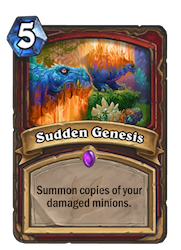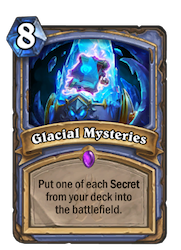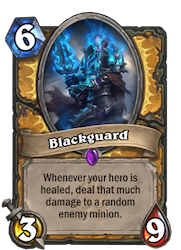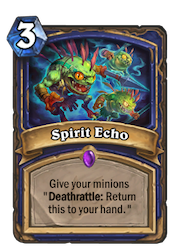Good News, Everyone!
Having a collection that allows you to build competitive Hearthstone decks is hard. Even if you spend money on the game, if your luck is poor or you haven’t been min-maxing your quests, you might find yourself two epics or one legendary short of any given deck. Luckily for you, though, the set rotation is coming with the April 2019 expansion! Not only does that mean you have 3 fewer sets to craft for Standard, you also may have some cards in the proverbial attic that you can trade for dust without affecting your future competitive prospects. Just think of me as Marie Kondo for your Hearthstone collection. The cards in this list probably don't spark joy.
Hey, Where’s Nat Pagle?
This guide is going to focus exclusively on cards from sets that are rotating out of Standard after the Year of the Raven comes to a close (Journey to Un’goro, Knights of the Frozen Throne, and Kobolds & Catacombs). Cards that are listed as safe to dust have seen virtually no play in the two years they’ve been in Standard, so they should be relatively safe to dust without worry that they’re suddenly going to be meta relevant in Wild. (Note: This isn’t a guarantee, and depends on how much you like to experiment; Knuckles was on last year’s list, and I found myself crafting it a couple of months ago.) Cards that are listed as having seen fringe play are just that; they were in decks that turned out to not be good enough to be meta relevant, or got swapped out for more powerful cards as decks got refined. They may see play again, but unless you’re a huge fan of that specific deck archetype, you can probably part with the card.
All that said, there are certainly cards that have not seen play in Classic and the more recent sets, but I’m not advocating you dust those for a couple of reasons.
If you’re still opening packs from any of those sets (and if you ever play Tavern Brawl, then you’re still opening classic packs) then dusting a legendary card gives you 400 dust now, but increases the chances you’ll open it again later. So if you leave Lorewalker Cho in your collection, you know that the next time you hear the Innkeeper shout, “Woah, legendary!” it’s not going to be Cho rearing his ugly head again, for instance.
Also, cards go in and out of the meta depending on what’s printed. If I wrote a guide like this a year ago, Hadronox and Master Oakheart might have been on it, because neither saw any significant play last year. Once The Witchwood introduced Witching Hour, however, both of those became critical cards in Taunt Druid, so you’d be sad if you’d dusted them. That doesn’t mean you should never dust any cards that are currently in the standard rotation, but they’re not as cut and dry as cards that have not seen any play for two years. And it’s worth mentioning that every legendary that you dust and later recraft sets you back net 1200 dust.
But I’m Never Going to Play Wild!
Sure, you aren’t.
I said the same thing when they first introduced Wild, but after playing Hearthstone for several years, I’ve enjoyed going over to Wild from time to time, either to play decks I used to enjoy, or just for a change of pace. The dust you’re going to get from cashing in your Wild cards isn’t even close to what you’ll spend if you decide you want to play Cube Warlock or Deathrattle Hunter again. So my advice is to be surgical about what you dust, and this guide is intended to be your scalpel. Or something.
Also, special thanks to Duwin of Team One Trick for providing his insight into these recommendations as a regular deck builder in Wild. He made sure these recommendations take into account all the latest Wild meta developments as of this writing.
Enough chit chat, though. Let’s go find you some treasures!
Legendary - Safe to Dust
Journey to Un’Goro
Lakkari Sacrifice: Even with all of the support Team 5 tried to give Quest Warlock in Rastakhan’s Rumble, none of that fixes the fact that the quest reward just isn’t good enough. Two 3/2s a turn just end up being speed bumps by the time you get to play the Nether Portal, and you’ve discarded the rest of the cards that would help you be able to use them effectively.
Clutchmother Zavas: See Lakkari Sacrifice.
The Voraxx: I speak for the weeds, and the weeds say that this card has always been very awkward to play with not enough payoff, even in decks like Egg Paladin which should theoretically be able to abuse it.
Ozruk: Elemental decks have always been a couple of notches in power level below the rest of the meta, and a theoretical 5/15 for 9 mana began to seem quaint compared to the power level of other available taunts with less setup required.
Knights of the Frozen Throne
Professor Putricide: You would think that a card that gives you extra value from your secrets would have seen play in the era of Secret Hunter, but the problem with the not-so-good Professor is that the powerful secret synergies trigger off of playing secrets, not generating them from random effects. So a card that doesn’t pump up Emerald Spellstone, buff Secretkeeper, or get cast again from Zul’jin isn’t as valuable, and if Putricide’s effect plays a secret you’re already holding, it can leave you with a dead card unexpectedly. (Note that the recent nerf to Emerald Spellstone may leave more room for a 4 mana card like Professor Putricide in Wild Secret Hunter builds; if that becomes the case I’ll update this guide accordingly, but as of this writing that hasn’t happened yet.)
Bolvar, Fireblood: Ultimately, this card is too fair. It’s a 1/7 who becomes a 3/7 the first time it takes damage, but it needs a core of divine shield synergy to take advantage of it, and that kind of synergy only seems to happen in an even deck with Hydrologist and Argent Protector, where Bolvar’s odd mana cost is prohibitive; without the added boost of the discounted hero power, Bolvar is underwhelming.
Lilian Voss: In theory, this would recycle all the junk you get from burgle effects. In practice, you generally want something better than a Chillwind Yeti that turns your bad spells into other bad spells, and often you only hit one or maybe two of them.
Moorabi: Freeze shaman in 2019 LOL.
Blood Queen Lana’thel: See Lakkari Sacrifice.
Arfus: Arfus is a very good boy, but it’s not a very good card. The secret about The Lich King is that the actual cards that it generates aren’t the reason the card is good; anyone who’s gotten a single Death Knight card and had it be completely inappropriate for the game state can tell you that. The reason The Lich King sees play is that the Death Knight card comes along with an 8/8 taunt that is both a threat in terms of the body as well as a threat to generate additional Death Knight cards, and regression to the mean promises that, should The Lich King stick to the board, enough of those cards will create a significant advantage. Arfus does neither of those things, and so it’s just an overcosted minion who sometimes gives you a gift and sometimes saddles you with a dead card.
Prince Valanar: The 4 mana slot is probably the hardest to omit from a deck compared to Keleseth and Taldaram, and the payoff is arguably the least impactful. It’s not helped by the fact that another card introduced in this set is Corpsetaker, which effectively does the same thing but with less onerous deckbuilding requirements. In fact, there was a standard deck with 30 legendary minions recently, and that had only one minion that costed 4 mana, and it wasn’t Prince Valanar.
Kobolds & Catacombs
Temporus: If there was a good way for Priest to live through two turns and then exploit the extra turn, given the golden age of OTK decks that the Rastakhan Standard meta has evolved into, we’d have seen it by now. That’s not to say it could never happen; Wild has seen stranger things, but you’re probably better off using that dust for better things.
The Runespear: General rule: “Targets chosen randomly” is good when it triggers multiple times from an effect (see Yogg-Saron, Zul’jin) and bad when it triggers once (Runespear, Tortollan Primalist, Servant of Yogg-Saron). The reason for this is regression to the mean; one spell may or may not do anything useful, but given enough activations you’re likely to get an effect that benefits you. The pool of spells is too large to accurately predict what The Runespear will do against any given board state, and that’s even more true in wild where there are so many more good shaman spells for The Runespear to choose from.
The Darkness: This was predominantly played as a (mostly ineffective) tech against Reno/Kazakus decks because it would shuffle three of the same card into the opponent’s deck. It fell out of favor quickly because it wasn’t effective at countering those decks, and it sees zero play in wild now despite Reno decks still being a thing in Wild.
Legendary - Has Seen Fringe Play
Journey to Un'goro
Tyrantus: This saw play briefly in big druid decks like, well, Big Druid and Undahtakah Druid, but that was also before Wild Growth and Nourish were nerfed. In Wild, there could be enough ramp now or in the future to make a big dumb dino for ten mana work again.
The Marsh Queen: Like Lakkari Sacrifice, the reward just isn’t worth building your deck around the hunter quest. A parade of 1 drops is generally answered by all the AoE available even in more limited metas.
Swamp King Dred: In theory, this should be a slam dunk in a Deathrattle Hunter or even just as a big threat that needs to be addressed. In practice, a minion that turns your opponent’s minions into removal spells isn’t that great. That said, given how OTK decks are becoming a bigger part of the Wild meta, there’s an outside chance that Swamp King Dred could see play again as a way to disrupt combos that rely on a series of minions (such as Mecha’thun Priest, where killing the Reckless Experimenter before the end of the turn keeps it from triggering the Coffin Crasher and Ticking Abominations that summon Mecha’thun and then clear the board).
The Last Kaleidosaur: Vilespine Slayer is a card.
Unite the Murlocs: Murloc shaman’s been tried a few times, but your opponent really just needs a couple of AoEs and then your entire game plan is null and void.
King Mosh: This has been used in some control warrior builds, but the best activator has always been Blood Razor, and since most control warriors have moved to Odd to take advantage of Tank Up, Mosh has been cut in favor of things like Supercollider.
Archbishop Benedictus: If you have a lot of time to spare and don’t mind getting friend requests that turn out to not be so friendly, you can play Archbishop Benedictus in a Quest Priest or to just run your opponent out of resources or the will to live, whichever comes first. But you probably have better things to do with your time. (Note that it is sometimes run in Reno Priest builds that are looking to counter fatigue strategies, so if that’s a style of deck you enjoy, maybe put Ben lower on your to-dust list.)
Rotface: Recruit warrior was a thing briefly, and Rotface was a decent expensive minion to summon who could be difficult to clear, but recruit warrior just turned out to not be as good at control as Odd Warrior, and all the warrior recruit cards (not to mention most of the cards worth recruiting) are even costed.
Scourgelord Garrosh: This sees play in some tempo lists from time to time, only because the weapon is so good, but it often ends up as the first card cut because most warrior decks also have another hero power that’s not Armor Up, and overwriting tank up or Dr Boom or Die, Insect is really bad. It also sees play in the occasional Dead Man’s Hand or Recruit Warrior build, but see Rotface for thoughts on the potential of the latter.
Thrall, Deathseer: Evolve shaman was a thing for a while, but the problem with changing your hero power to something that requires a minion on board is eventually you run out of minions. Given that most of the death knights were effectively standalone win conditions (and that Hagatha was just a straight upgrade), Thrall fell off quickly.
Kobolds & Catacombs
Ixlid, Fungal Lord: Ixlid saw play in some builds of Malygos Druid for a while before the Aviana nerf. Assuming Druid eventually gets back to doing broken things in wild, Ixlid may be a part of it, but it’s been MIA since the days where you could play it easily for one mana are over.
Dragon Soul: At the beginning of each expansion, someone inevitably puts together a Miracle Priest with Lyra, Radiant Elemental, a bunch of cheap spells, and Dragon Soul. Then the Dragon Soul gets cut. Then the deck fades into oblivion. You can set your watch to it.
Woecleaver: See Rotface.
Epic - Safe to Dust
Journey to Un’Goro
Stampede: You’d think this would make its way into the current Midrange Hunters that run Scavenging Hyena and Master’s Call, but it turns out that any deck that summons enough beasts in one turn to make Stampede worthwhile aren’t concerned with value generation; they just want to kill the opponent ASAP.
Dinomancy: If you’re giving up your hero power, would you rather give a beast +2/+2 or generate giant beasts out of thin air? I’d take Rexxar, too.
Primalfin Champion: This was supposed to be the card that made Quest Paladin work, but it ends up being extremely weak to silence, as is the Quest Paladin reward. Once Lynessa Sunsorrow was printed, that became a better payoff for buffing your minions anyway.
Biteweed: The difference between Edwin VanCleef and Edwin VanLeaf is +2/+2 versus +1/+1. The latter just requires too big of a turn to get value, and if you were able to play that many cards in a turn, you probably don’t need a medium-to-large sized minion alongside it.
Stone Sentinel: Elemental synergies were hard to trigger to begin with, and Blazecaller is just a better 7-drop with an elemental trigger than Stone Sentinel.
Chittering Tunneler: Warlock spells have gotten better in recent sets, but they generally aren’t good enough to pay life for, and there are enough narrowly situational and/or just plain bad warlock spells that you couldn’t be guaranteed to get value over just playing the card you wanted in the deck.
Explore Un’goro: In general, you need to have a good reason to want to throw away all the cards you chose to put in your deck. Hakkar shuffling Corrupted Bloods into your deck is one reason, but that doesn’t happen enough for this to be a legit tech card.
Sudden Genesis: This is a lot of fun if you’re trying to build a Blackhowl Gunspire deck. (And I highly encourage that if you have the cards!) But otherwise, the best use of this card is maybe copying a damaged Grommash Hellscream, and there are better ways to do that much face damage at once.
Emerald Hive Queen: If you’re going to play a 1 Mana 2/3, Zombie Chow and Saronite Taskmaster are both better options.
Tortollan Primalist: I wanted so badly for this card to be good. It’s a turtle! He shouts “Wicked!” when he attacks! You can control the discover pool based on the class! But you can only get Pyroblasted in the face so many times before facing the realization that this card isn’t good, and wild has too many spells in the discover pool to be able to make it even sort of predictable.
Knights of the Frozen Throne
Fatespinner: The problem with this card is that the board state at the time you play it makes it pretty obvious what choice you took on the deathrattle. And secrets aren’t valuable if the information isn’t hidden.
Toxic Arrow: This looks like it could be flexible removal, but generally if you’re trying to use your minions as removal, Crackling Razormaw and Rexxar both create poisonous minions often enough that you don’t really need this card.
Abominable Bowman: Bowman is a card that’s not good enough no matter which deck it runs in. In a midrange/beast hunter you’re very likely to bring back a 1/1, which is not the result you’re looking for out of a 7-drop. In deathrattle hunter, where only your big bomb minions are beasts, it’s a dead card until turn 8 or so, which is too slow even for that deck.
Glacial Mysteries: Any mage deck that’s run enough secrets to even consider playing Glacial Mysteries would very much prefer that their opponent would be dead by turn 8. Also, Subject 9 ends up being a better version of this card, since you generally want to play secrets from hand, both to control the timing as well as to trigger secret synergies.
Light’s Sorrow: See Bolvar. This could run in Even Paladin, but when you’re already running Val’anyr and Truesilver Champion, there are only so many deck slots for weapons.
Blackguard: Even with all the healing support introduced for Paladin in Rastakhan, it turns out that randomly damaging opposing minions just isn’t good enough when you can just clear with Equality or Shrink Ray.
Embrace Darkness: Bad Mind Control didn’t see play in Standard, and it’s going to have an even harder time in Wild where Entomb is a card at the same mana cost with no downside.
Spectral Pillager: It takes so many cards played to get this to do any relevant amount of damage that you probably don’t need that damage in the first place.
Cryostasis: If freeze shaman ever becomes a thing then you can play this card, but you could wait an ice age for that to happen.
Rattling Rascal: There isn’t too much of a payoff for a minion that has a good battlecry with a bad deathrattle to offset it; most of the cards that see play are the reverse, where they’re recruited or resurrected.
Tomb Lurker: Most of the decks that are playing minions worthwhile enough to return to your hand can just resurrect them. Not to mention that your opponent can disrupt it by playing their own deathrattles.
Furnacefire Colossus: The only deck that runs enough weapons to make use of this is pirate warrior, and pirate warrior doesn’t want to spend 6 mana for a big, dumb minion that doesn’t go face immediately.
Kobolds & Catacombs
Deck of Wonders: Unless you’re committed to hardcore meming, you don’t need to keep this in your collection. You can always get this from Primordial Glyph.
Windshear Stormcaller: If you’re going through the work of getting the stars to align to get this card’s battlecry to go off, you’re going to need way more value than a free Al-Akir to justify playing this card in wild.
Shimmering Courser: Maybe if Quest Paladin was more popular this would see more play, but there are enough battlecry minions that can be used for removal (Voodoo Doll, Vilespine Slayer, etc) that the card text generally isn’t enough to offset the underwhelming stat line.
Epic - Has Seen Fringe Play
Journey to Un’Goro
Giant Anaconda: If you’re hanging on to Jungle Giants, then this is one of the cards that made that deck work. Outside of that deck, though, even Big Druid eventually cut the big snakes for just better big minions that didn’t rely on your hand composition to be more than a vastly overstatted minion.
Spirit Echo: This saw play early on in Un’goro, back when Token/Evolve Shaman was a popular deck, to get more value from your battlecry minions. In general, though, that strategy isn’t super effective in general with subsequent expansions, and you’re probably better off getting a copy of this card generated from something like Hagatha rather than spending a valuable deck slot on it.
Knights of the Frozen Throne
Treachery: It looked like there would be a deck that might play detrimental deathrattle minions and use Treachery to weaponize them, but since no other card similar to Treachery ever appeared, this got limited to a fairly evil combo with Defile and Howlfiend to simultaneously discard an opponent’s hand and clear their board. Control-style warlocks have plenty of tools without needing to resort to that kind of trickery, though, especially in Wild.
Kobolds & Catacombs
Crushing Walls: This saw some play in Spell Hunter from time to time, based on the meta and the available cards, but it’s pretty easily replaced even when it’s meta relevant.
Evasion: This occasionally gets played in OTK style rogues like Malygos Rogue. It’s obvious what secret it is, but it doesn’t matter because your opponent can’t really play around it effectively.
Bladed Gauntlet: Jambre built an Even Warrior that was able to make use of this as early game removal thanks to a hero power that gives you 2 armor for 1 mana, but that was the only time this card saw play, especially once control warrior started to exclusively move to Odd Warrior builds.
Thanks For Reading!
If you like this content, please consider subscribing to my weekly podcast, Off Curve, where I talk about Hearthstone while driving home on my commute. You can find it in iTunes and on Google Play. You can also follow me on Twitter and Twitch for more Hearthstone content. Thanks for reading!

























































